The Samsung 850 EVO 4TB SSD Review
by Billy Tallis on July 11, 2016 10:00 AM ESTRandom Read Performance
The random read test requests 4kB blocks and tests queue depths ranging from 1 to 32. The queue depth is doubled every three minutes, for a total test duration of 18 minutes. The test spans the entire drive, which is filled before the test starts. The primary score we report is an average of performances at queue depths 1, 2 and 4, as client usage typically consists mostly of low queue depth operations.
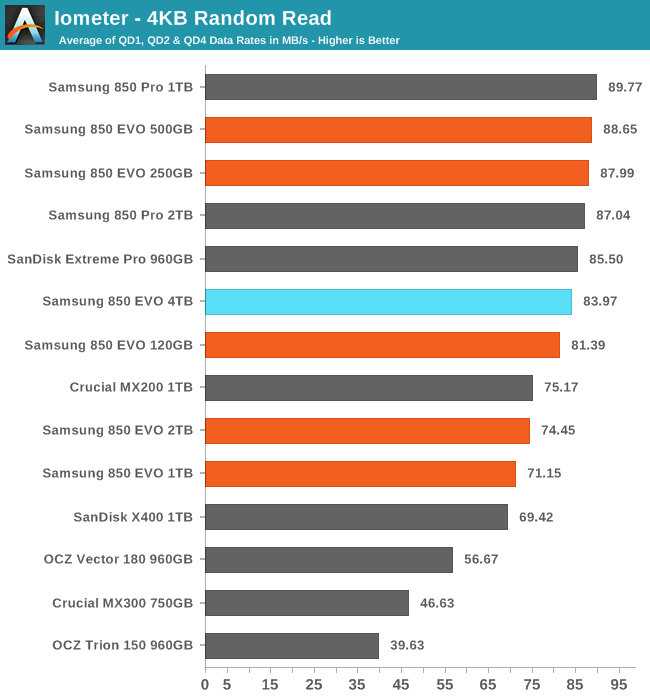
Random read performance of the 4TB 850 EVO is substantially better than the 1TB and 2TB 850 EVOs, but still not quite as fast as the best MLC drives or the 500GB and 250GB 850 EVOs.

The power consumption of the 4TB 850 EVO is slightly higher than the 2TB model, but overall the efficiency is improved over the smaller drive with the same controller but older NAND.
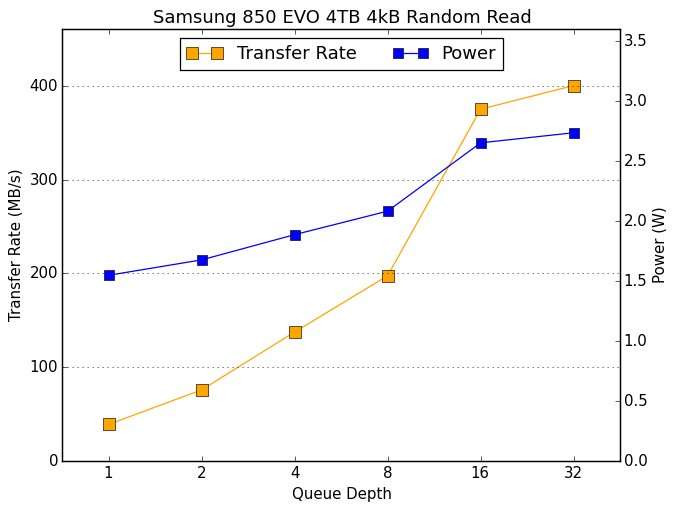 |
|||||||||
The scaling behavior of the 4TB 850 EVO is almost identical to the 2TB model, just with slightly higher performance and power consumption across the board.
Random Write Performance
The random write test writes 4kB blocks and tests queue depths ranging from 1 to 32. The queue depth is doubled every three minutes, for a total test duration of 18 minutes. The test is limited to a 16GB portion of the drive, and the drive is empty save for the 16GB test file. The primary score we report is an average of performances at queue depths 1, 2 and 4, as client usage typically consists mostly of low queue depth operations.
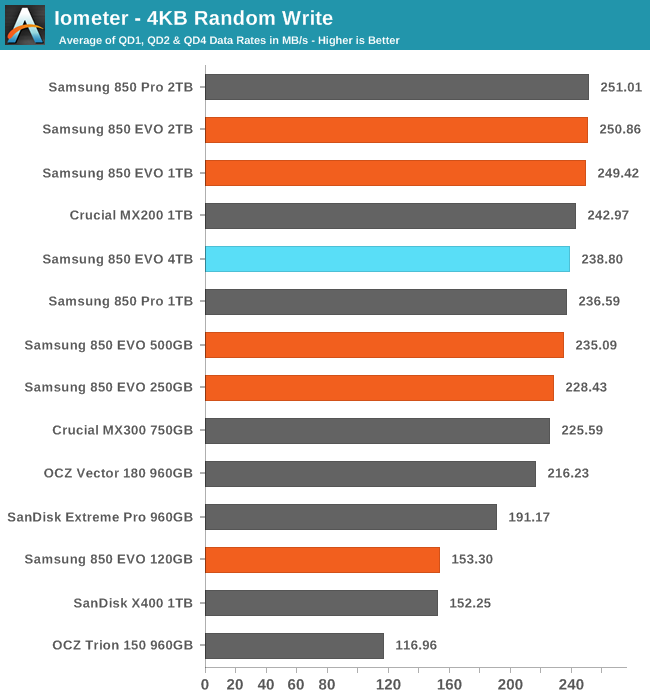
Random write speed for the 4TB 850 EVO is a little bit slower than for the 1TB and 2TB models, but still fast enough to beat almost all non-Samsung drives.
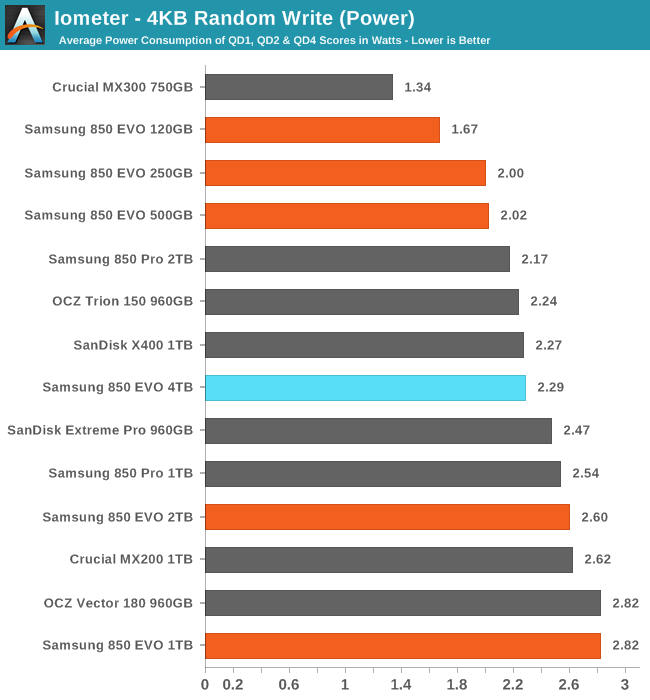
Power consumption of the 4TB 850 EVO is substantially better than the 1TB and 2TB counterparts, making it one of the most efficient large drives. The 750GB Crucial MX300 was still much more efficient.
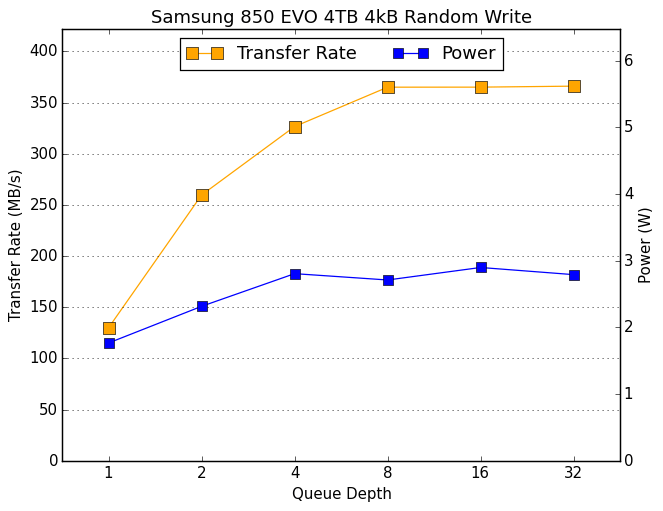 |
|||||||||
The lower performance score for the 4TB was apparently due to a regression in QD4 performance, where the 1TB and 2TB models were able to reach full speed but the 4TB needs a larger queue.










145 Comments
View All Comments
Enigmatica - Monday, July 11, 2016 - link
Silh is right. My DAW system has 64GB of RAM and all of my samples are stored on a 400GB Intel PCIe NVME drive. I'm only a hobbyist but my set of samples is well into the 200GB range. Pros with all of the gear can easily break 1+ TBddriver - Monday, July 11, 2016 - link
Pros are actually invested in making music than obsessing with sample hoarding ;)NI KOMPLETE is 100 GB and it has pretty much everything you are ever going to need. Naturally, that means actual analog instruments. A lot of mediocre pseudo musicians obsess on hoarding what is not instrument samples but ready to use loops they can play and imagine they are doing music. The format of distribution of that stuff is as stupid as it is itself - since it is not really live performance and usually synthesized sound, it could just as well be distributed as midi + synthesizer presets, and take kilobytes rather than gigabytes - a million times less space...
smilingcrow - Monday, July 11, 2016 - link
Classic “I know what’s best for everybody” rant by someone that fails to understand the topic they are discussing.DPUser - Monday, July 11, 2016 - link
Smilingcrow is right on point here. While ddriver's words may accurately convey the mindset of a certain subset of "musicians" using computers, VI orchestrators and pro producers in many genres are not just using loops; describing these writers, arrangers, performers and engineers as "pseudo musicians" indicates a complete lack comprehension as to how these extremely talented folks work.And while is NI Komplete is wonderful, it is not (yet, if ever) the be all and end all. Incredible VIs are being developed every day by other developers, bringing new levels of fidelity and expression, making greater demands on system real-time performance and soaking up ever-increasing swaths of storage space.
Silh - Monday, July 11, 2016 - link
Have a look at some of the professional orchestral libraries. These are not loops, or instrument runs, but individual note samples, recorded with multiple articulations, velocity layers, different mic positions, etc. You're looking at at 300GB+ for, say, just the strings. VSL's full orchestra comes in about 1TB if you put everything together (and priced waaaaaaaay out of what I can afford).Daniel Egger - Monday, July 11, 2016 - link
RAW Photo editing is harmless: you import all data once and from then on it's mostly reading data. Even if you're a pro you'll have a hard time filling 4x64GB cards a day and you certainly won't sustain that throughout a year. So even if you believed in that segment-my-ass 300TB endurance figure you'll be using it for 3 or 4 years...ddriver - Monday, July 11, 2016 - link
Sure, editing involves mostly reading, you edit the photos then throw away the changes. But even then, photoshop will generate tens of gigabytes of temporary scratch files ;)smilingcrow - Monday, July 11, 2016 - link
A prosumer would be using a separate scratch disk with Photoshop though if they wanted top performance.Impulses - Monday, July 11, 2016 - link
Cheap(er) SATA drives for RAWs here (2x1TB EVO atm), SM951 for the apps and their libraries/scratch.mapesdhs - Wednesday, July 13, 2016 - link
Keep posting your sensible example config, I like that. 8)